Aug. 26, 2019 Arts Journal article by Diane Ragsdale is entitled “The Changing Face of Arts Engagement: My remarks at the Stratford Festival Forum”
This post is concerned with the preservation of the parks system in Stratford, Ontario, in the early 1900s. It’s also concerned with the transcript of a 2019 Meighen Forum presentation which I found of interest.

Tom Patterson Theatre Centre site, Nov. 14, 2018, view from Water Street looking north. Text reads: “A pretty plot, well chosen to build upon!” – Henry VI, Part 2.” Jaan Pill photo
In the early 1900s, many residents of Stratford favoured building of a railway line through a park system along a stretch of the Avon River which runs through the city. Many others were opposed to such a railway route.
Residents of Stratford were involved in making the choice. That fact warrants strong emphasis. It is highly inspiring and significant when residents have direct input regarding land use decisions that directly affect them.
In the end, Stratford held a referendum. When the votes were counted, residents opposed to building of the railway through the parkland came out ahead by a margin of 127 votes. That set the stage for many good things that have occurred in Stratford in the decades that followed. The decision made good economic sense.
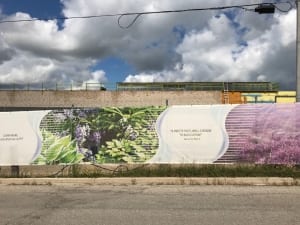
Tom Patterson Theatre Centre site, view from Water Street looking north, Sept. 7, 2019. Jaan Pill photo
The decision was in accord, that is, with standard principles of late capitalism and standard principles of what in the current era is known as neoliberalism. The key question was: How do you best frame the discussion, when such a choice (between a railway line and the preservation of a park system) needs to be made?
In 1952, the city’s park system was chosen (by Tyrone Guthrie and colleagues) as the site for construction of the Festival Theatre, where the Stratford Festival was launched in 1953.
The festival helped the city to address the postindustrial economic decline that affected many communities starting in the 1950s.
The photos at the current post are from the Tom Patterson Theatre Centre construction site along the park system in Stratford. [Update: The original name was “Tom Patterson Theatre Centre”; in the current post, I’ve left the name as it was; subsequently, the name was changed to its current version, “Tom Patterson Theatre.”]
The new venue will among other things provide a setting for events at the Meighen Forum at the Stratford Festival.
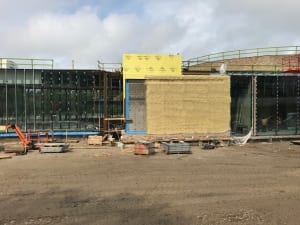
Tom Patterson Theatre Centre site, looking north from Water Street, Aug. 27, 2019. The rectangle in the foreground has at this stage not yet been covered in a layer of bricks. Jaan Pill photo
An Aug. 26, 2019 Arts Journal article by Diane Ragsdale, entitled “The Changing Face of Arts Engagement: My remarks at the Stratford Festival Forum,” offers an overview of topics at a previous event. A transcript of Diane Ragsdale’s Aug. 16, 2019 talk at the Meighen Forum can be accessed here:
Changing Face of Arts Engagement – Diane Ragsdale
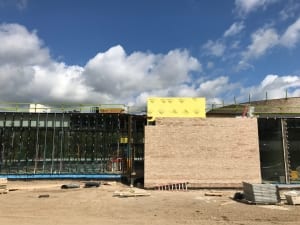
Tom Patterson Theatre Centre site, looking north from Water Street, Sept. 7, 2019. The rectangle in the foreground has now been covered in a layer of bricks. Jaan Pill photo
The above-noted article and related comments share valuable reflections regarding perennial topics of interest including the business model which accounts for the economic viability of the Stratford Festival.
The above-noted transcript also speaks of the value of human connection.
An Aug. 27, 2019 CBC article, entitled “How the rise of the automated lifestyle might threaten our ability to connect,” underlines the value of such a connection. In my public school teaching career (I retired in 2006), I especially enjoyed role play and drama in the classroom.
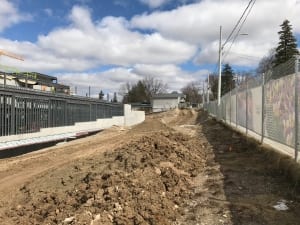
Tom Patterson Theatre Centre site, looking east along Water Street, April 10, 2019. In the background, the Stratford Optimist Hall, a white building with a gray roof is visible. Jaan Pill photo
Tyrone Guthrie, who served as artistic director in the early years at the Stratford Festival, has shared reflections about a lifetime in theatre. Among his written works are:
In Various Directions: a View of Theatre (1965)
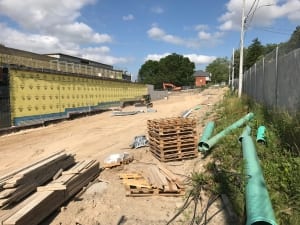
Tom Patterson Theatre Centre site, view looking east along Water Street, July 11, 2019. In the background, the Stratford Optimist Hall is no longer visible, as by this date it had been demolished. Jaan Pill photo
While he was himself favourably positioned within the strongly hierarchical, strongly status-oriented British class system, Guthrie viewed the world from beyond such a class-based framework.
Educated at Oxford after entry on a history scholarship, Guthrie (1900-1971) turned to theatre after deeming other career options available to him unappealing. He turned to theatrical directing after realizing he was not made out to be an actor.
Guthrie’s early work included directing radio plays for BBC Radio, then newly launched. Long before his work in Stratford, Ontario, he also directed plays about Canadian history for a national radio service in Canada launched by the railway industry. In those days he got to know Montreal and other cities well.
Also of interest: Missing minutes, Stratford parks board meetings
From what I have read of events in Stratford in the early 1950s, there has been conjecture that R.Thomas Orr may have been originally opposed to the building of the Festival Theatre at a location near the corner of Queen Street and Ballantyne Avenue at the edge of the park system.
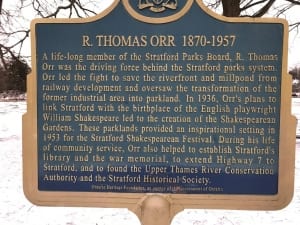
Plaque in honour of R. Thomas Orr. North of Veterans Drive a short distance west of Wellington Street North. Jaan Pill photo
Orr’s concern might have been that it would have been better to leave the parkland as it was. However, the official version of the story, as I understand it, is that in the end, Orr did support the launch of the Stratford Festival, which has brought significant economic value to the city.
Some minutes of Stratford parks board meetings, at which Orr and other residents spoke for and against the construction of the Festival Theatre within the Stratford park system, have disappeared long ago, according to what appears to be a reliable account that I have been reading.
I’ve also been reading that Orr was consistently involved, over many decades, in preservation of historical records of every description related to the settler colonial history of Stratford and Southwestern Ontario. Circumstantial evidence suggests that he may possibly have had a role in the disappearance of the parks board minutes. In the absence of evidence, no definitive statement can be made.
What is evident, however, is that local history narratives regarding R. Thomas Orr’s contributions to Stratford’s development as a cultural tourism destination are a strong source of inspiration.
Southwestern Ontario land use
Since moving to Stratford in October 2018, I’ve kept in touch with land use issues in Toronto and elsewhere.
Reading of studies such as Seeing Like a State (1998) and Community (2011), highlighted at a previous post, has helped me to learn how the concept of legibility, as a heuristic or analytical tool, can help a person better understand what land use entails.
At times I stop to marvel at the fact the Stratford Festival and the building of the Tom Patterson Theatre Centre, slated for completion in 2020, are part of an innovative and visionary project that was initiated and continues to flourish.
Preservation of built heritage, and of heritage features such as urban park systems, is not some counter-cultural, arcane endeavour.
It is, instead, a valid, economically viable project that warrants celebration and commendation, even as a strictly hard-nosed business proposition.
Arts engagement and longevity
A Dec. 18, 2019 BMJ article is entitled: “The art of life and death: 14 year follow-up analyses of associations between arts engagement and mortality in the English Longitudinal Study of Ageing.”
An excerpt reads:
Receptive arts engagement could have a protective association with longevity in older adults. This association might be partly explained by differences in cognition, mental health, and physical activity among those who do and do not engage in the arts, but remains even when the model is adjusted for these factors.

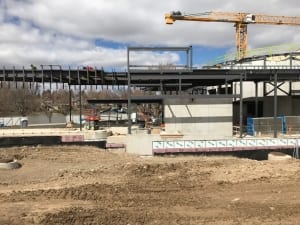
Leave a Reply
Want to join the discussion?Feel free to contribute!